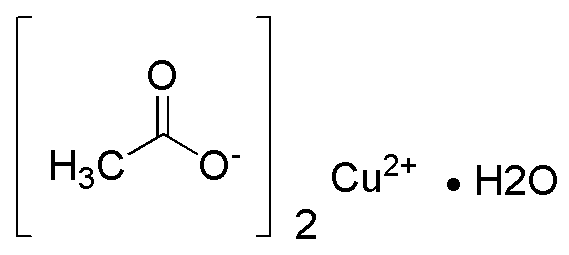Copper(II) acetate monohydrate is widely utilized in research focused on:
- Organic Synthesis: This compound serves as a catalyst in various organic reactions, enhancing reaction rates and yields, particularly in the synthesis of complex organic molecules.
- Analytical Chemistry: It is employed in the preparation of reagents for the qualitative and quantitative analysis of different substances, making it essential in laboratories for accurate measurements.
- Electrochemistry: Used in the development of electrochemical sensors, it helps in detecting and measuring various analytes, which is crucial in environmental monitoring and quality control.
- Textile Industry: Copper(II) acetate monohydrate is applied as a mordant in dyeing processes, improving color retention and vibrancy in fabrics, which benefits textile manufacturers.
- Biological Research: It plays a role in studying enzyme activities and metal ion interactions in biological systems, aiding researchers in understanding metabolic pathways and developing pharmaceuticals.
General Information
Properties
Safety and Regulations
Applications
Copper(II) acetate monohydrate is widely utilized in research focused on:
- Organic Synthesis: This compound serves as a catalyst in various organic reactions, enhancing reaction rates and yields, particularly in the synthesis of complex organic molecules.
- Analytical Chemistry: It is employed in the preparation of reagents for the qualitative and quantitative analysis of different substances, making it essential in laboratories for accurate measurements.
- Electrochemistry: Used in the development of electrochemical sensors, it helps in detecting and measuring various analytes, which is crucial in environmental monitoring and quality control.
- Textile Industry: Copper(II) acetate monohydrate is applied as a mordant in dyeing processes, improving color retention and vibrancy in fabrics, which benefits textile manufacturers.
- Biological Research: It plays a role in studying enzyme activities and metal ion interactions in biological systems, aiding researchers in understanding metabolic pathways and developing pharmaceuticals.
Documents
Safety Data Sheets (SDS)
The SDS provides comprehensive safety information on handling, storage, and disposal of the product.
Product Specification (PS)
The PS provides a comprehensive breakdown of the product’s properties, including chemical composition, physical state, purity, and storage requirements. It also details acceptable quality ranges and the product's intended applications.
Certificates of Analysis (COA)
Search for Certificates of Analysis (COA) by entering the products Lot Number. Lot and Batch Numbers can be found on a product’s label following the words ‘Lot’ or ‘Batch’.
*Catalog Number
*Lot Number
Certificates Of Origin (COO)
This COO confirms the country where the product was manufactured, and also details the materials and components used in it and whether it is derived from natural, synthetic, or other specific sources. This certificate may be required for customs, trade, and regulatory compliance.
*Catalog Number
*Lot Number
Safety Data Sheets (SDS)
The SDS provides comprehensive safety information on handling, storage, and disposal of the product.
DownloadProduct Specification (PS)
The PS provides a comprehensive breakdown of the product’s properties, including chemical composition, physical state, purity, and storage requirements. It also details acceptable quality ranges and the product's intended applications.
DownloadCertificates of Analysis (COA)
Search for Certificates of Analysis (COA) by entering the products Lot Number. Lot and Batch Numbers can be found on a product’s label following the words ‘Lot’ or ‘Batch’.
*Catalog Number
*Lot Number
Certificates Of Origin (COO)
This COO confirms the country where the product was manufactured, and also details the materials and components used in it and whether it is derived from natural, synthetic, or other specific sources. This certificate may be required for customs, trade, and regulatory compliance.


